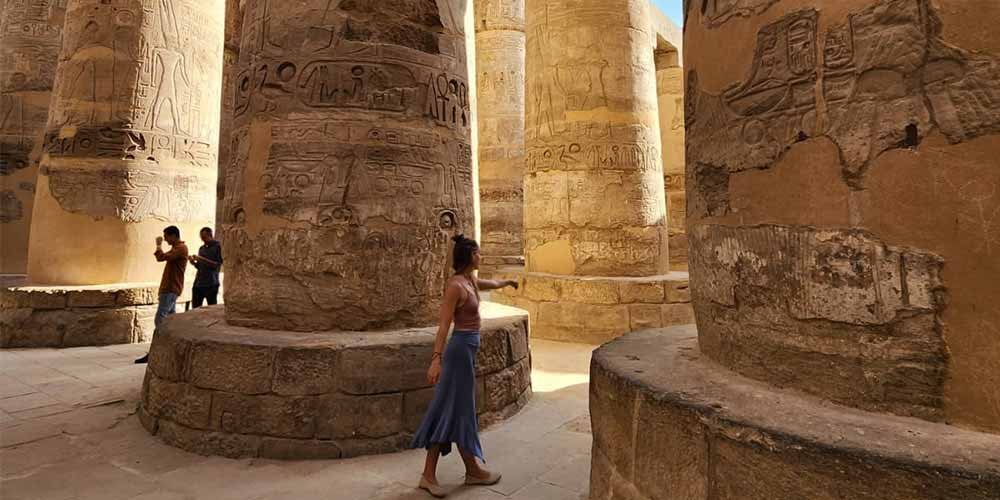Magnificent Temple of Karnak 5 Facts about Temple of Karnak.
Journey Through Temple of Karnak: Witnessing Millennia of Divine Dance
Amidst the vast, sandy landscapes of Egypt, there is a place where stone columns rise against the horizon, and hieroglyphs tell tales of gods, pharaohs, and centuries gone by. This is the Temple of Karnak, an architectural marvel and one of the grandest expressions of ancient Egyptian religious devotion.
The complex of religions, built by 30 pharaohs. Karnak Temple Complex, known as Karnak Temple, is a stunning temple complex of unrivaled beauty, as Karnak comprises the temples of the god Amun, his wife, the goddess ‘Mut’ and his son, the god ‘Khonsu “, which is considered the second most visited historical site in Egypt, after the pyramids of Giza. The “Road of Rams” represents the main gate of the temple, and is composed of two rows of statues of a group of rams, where on both sides of the road are 1,200 statues in the shape of a ram-headed sphinx, that head it symbolizes the god Amon, and was placed in this way as a sort of protection for the temple. And in the center of Karnak is the “Sacred Lake”, that lake which is still considered one of the secrets of the Pharaohs today, with its calm waters which do not dry up throughout the year, despite its distance from the Nile River.
The Historical Canvas
Temple of Karnak, Located near the modern city of Luxor (ancient Thebes), the Temple of Karnak isn’t just one temple; it’s a vast complex of sanctuaries, pylons, and obelisks dedicated to the Theban gods and the greater glory of Egypt’s pharaohs. Spanning over 200 acres, its construction is the effort of numerous pharaohs over two millennia, making it the largest religious building ever made.
The ancient Egyptians referred to Karnak’s temple as Ipet-isu, or “most select of places”. It is a 2,000-year-old temple city dedicated to the Theban triad of Amun, Mut, and Khonsu. This derelict site can still overshadow many modern wonders and must have been awe-inspiring in its day.
Temple area
The Hypostyle hall, at 54,000 square feet (16,459 meters) and 134 columns, remains the world’s largest religious building room. In addition to the main sanctuary, there are several smaller temples and a large sacred lake measuring 423 feet by 252 feet (129 by 77 meters). The sacred barges of the Theban Triad used to float on the lake during the annual Opet festival. The lake was surrounded by storerooms and priests’ living quarters, as well as an aquatic bird aviary.
Architectural Splendors
The heart of the complex is the Great Temple of Amun, the chief god of Thebes. It houses the awe-inspiring Hypostyle Hall, which is a forest of 134 colossal columns arranged in 16 rows. When one stands beneath these stone giants, it’s easy to feel both humbled and mesmerized.
Surrounding the main sanctuary are smaller temples and chapels, each with its own significance, dedicated to different deities or pharaohs. The Sacred Lake, used for ceremonial purposes, reflects the silhouettes of nearby structures, providing a tranquil contrast to the monumental edifices.
A Tapestry of Tales
Every stone and column in the Temple of Karnak is inscribed with hieroglyphs, showcasing religious rituals, tales of battles, and praises for the gods and the pharaohs. The temple served not only as a place of worship but also as a chronicle of the achievements and aspirations of ancient Egypt’s rulers.
 Festivals and Ceremonies
Festivals and Ceremonies
The Karnak temple was the epicenter of the Opet Festival, an annual event where statues of Thebes’ triad of gods (Amun, Mut, and their child Khonsu) were paraded from Temple of Karnak to the nearby Temple of Luxor. This event symbolized the reenergizing of the divine rulership, reinforcing the bond between gods and pharaohs.
The Modern-Day Experience
Today, the Temple of Karnak stands as a testament to Egypt’s enduring legacy. Visitors can witness the grandeur of the nightly sound and light show, which narrates the temple’s history against a backdrop of illuminated columns and statues.
In Conclusion
The Temple of Karnak isn’t merely an archaeological site. It’s a portal into the soul of ancient Egypt, where human ambition met divine inspiration. A place where the echoes of millennia-old chants can still be heard in the whispers of the wind, reminding us of a civilization that once was, and its quest for eternity.
Explore Egypt Tours Tripadvisor

Comment (0)